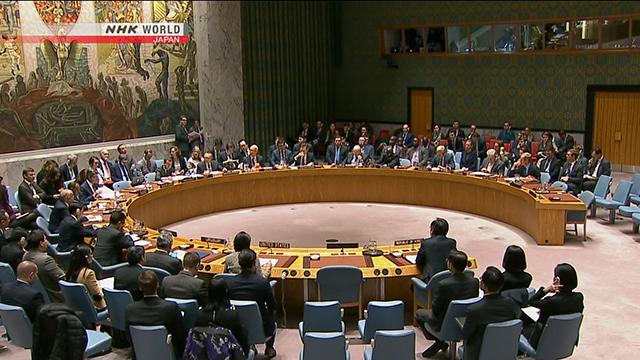The UN Security Council held an emergency meeting in New York in response to the launch. During the meeting, US Ambassador to UN Nikki Haley said that if a war were to break out, it would be because of continuous acts of aggression by the North. She said, "In addition to fully implementing all UN sanctions, all countries should sever diplomatic relations with North Korea."
Other countries like Japan are calling for more pressure on Pyongyang. Koro Bessho, the Japanese Ambassador to UN, says, "There is no choice for us but to work together to put maximum pressure on North Korea so that it alters its course of action and works towards denuclearization."
Meanwhile, China is cautious about tougher sanctions. It says dialogue is important. Diplomatic sources say it is unclear if China will agree to strengthen sanctions.
As for Russia, some of its lawmakers met with a close aide of leader Kim Jong Un, according to North Korea's state-run media. The aide explained the launch and emphasized the North's efforts to protect peace and security on the Korean Peninsula and in the world so that Russia can have righteous recognition.
The report said the Russian side responded that issues relating to the Korean Peninsula must be resolved in a peaceful manner, and that Russia's major parties are denouncing the US and its allies' policy toward Pyongyang.
In August and September, the Security Council unanimously adopted sanctions resolutions against Pyongyang. Among them were a total ban on coal imports from North Korea and a significant cap on oil-related exports to the North. Since then, the US, Japan, and South Korea have imposed additional unilateral sanctions, and the US has relisted North Korea as a state sponsor of terrorism.
It remains to be seen whether the member states will be able to show the same unity in their response to North Korea this time.
Japan: North Korea's latest missile likely new ICBM
The missile test-fired by North Korea on November 29th was its first in 2-and-a-half months. It is estimated to have reached an altitude of over 4,000 kilometers -- the highest ever for a missile fired by the country. It is also believed to have flown around 1,000 kilometers before falling into waters within Japan's exclusive economic zone, about 250 kilometers west of the Japanese prefecture of Aomori.
Japan's Defense Minister Itsunori Onodera said at an Upper House Committee the day after the launch that it appears to have been a new type of intercontinental ballistic missile.
He pointed out that images released by the North show the missile being carried on a mobile launcher never seen before, and North Korean media are extensively reporting that their missile was a Hwasong-15.
He said it can also be confirmed from the images that it was a 2-stage missile and the linear shape of the rocket flame is characteristic of liquid-fuel propulsion. The missile apparently separated into 3 during the flight.
The government also believes that it had a striking range of 12,000 to 13,000 kilometers and could potentially hit the US mainland, Russia, or Europe.
Prime Minister Shinzo Abe spoke to a Diet committee, and said that if Pyongyang were to acquire re-entry technology and successfully create a nuclear warhead small enough to fit onto the tip of a rocket, all nations would be threatened. The government is currently analyzing how much progress has been made with regard to these technologies.
Following the launch, Abe spoke by telephone with US President Donald Trump and South Korean President Moon Jae-in. The leaders reaffirmed that China has an important role to play. They also agreed to work together to further increase pressure on the North.
The Japanese government says sanctions against Pyongyang will have a bigger impact in the coming winter months. The government plans to continue to urge the international community to fully implement the sanctions that were imposed by the UN Security Council.
US Group of Experts says N.Korea's missile technology shows progress
A US research group says the missile had the capability of reaching the entire US mainland, but only with a relatively light payload.
The group at Johns Hopkins University released its analysis on November 30th. It says preliminary calculations show that the missile had a maximum range of 13,000 kilometers if launched at a standard trajectory, with light to no payload.
The group estimates that the missile was tested with a 150-kilogram payload. But it says it's doubtful North Korea could develop such a light nuclear warhead with its current technologies.
The group says that if the missile was fitted with a standard 500-kilogram payload, which would be more practical for Pyongyang to develop, the missile's maximum range will fall to roughly 8,500 kilometers. This still puts the US west coast within its range.
But the group says it remains unclear whether North Korea has acquired necessary technologies for developing warheads that can re-enter the atmosphere. It says it believes the North will need another year before it can develop a viable ICBM capable of reaching the US mainland.
